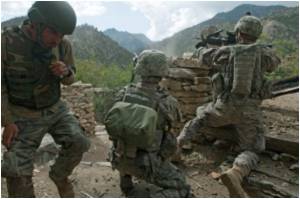A decade after the start of the wars in Afghanistan and Iraq, studies have shown that the incidence of post-traumatic stress disorder (PTSD) among troops is surprisingly low, and a

In an article that appears in the May 18 issue of Science, Professor of Psychology Richard J. McNally says there is reason for cautious optimism when it comes to the prevalence of PTSD. While early estimates suggested as many as 30 percent of troops might develop PTSD, current surveys show the actual rates ranging from 2.1 to 13.8 percent. The most rigorous survey of American troops found that 4.3% of all American military personnel deployed to Iraq and Afghanistan developed PTSD, and 7.6 of those reporting combat exposure did so.
"As a society we're much more aware of these issues than ever before," McNally said. "That is reflected by the fact that the military and the Veteran's Administration has established programs to ensure soldiers receive the best treatment possible. The title of my article is 'Are We Winning the War Against Post-Traumatic Stress Disorder?' I think a provisional answer to that is, 'Yes, we might be.'"
While part of the drop may simply be that wars are less lethal – in a decade of war in Iraq, fewer than 5,000 American troops were killed, compared to more than 55,000 killed over a similar period in Vietnam – McNally suspect that new efforts by the Army to tackle the disorder sooner, and ensure soldiers receive the best treatment available, may be helping, too.
The suggestion that 30 percent of troops might develop PTSD was based on the findings of the National Vietnam Veterans Readjustment Study (NVVRS), completed in 1990, which found that 30.9 percent of Vietnam veterans showed symptoms of the PTSD. While later analyses brought that number down, the findings served to galvanize Army efforts to address the risk of soldiers developing the disorder, McNally said.
"It's important to remember that simply being deployed carries a great deal of stress," McNally said. "Soldiers miss their family, and those who stay at home essentially become a one-parent family. Difficulties with children, or school or making ends meet – there are all kinds of stressors that have to do with separating families, let along having one member in a war zone. Fortunately, the military has taken steps to help soldiers cope with these stressors in addition to the traumatic combat stressors that can produce PTSD."
Advertisement
"It's not therapy per se, but a preventive intervention to help people put their experiences in perspective," McNally said, of the Battlemind training. "For example, it encourages soldiers to use the sort of emotional bonding that happens within units to reconnect with their families, and to see symptoms like hyper-vigilance not as symptoms of a mental disorder, but as something they need to adjust when they come home. It helps people realize that those things are part of the normal re-adjustment process."
Advertisement
Despite such efforts, however, some soldiers will develop PTSD, McNally said.
Those who do will now have access to what are known to be the best treatments for the disorder, including prolonged exposure and cognitive processing therapy.
"Until this initiative, less than 10 percent of the clinical specialists in PTSD used these treatments," McNally said. "These treatments weren't available to veterans of the Vietnam War – they were only developed in the 1990s – and the evidence shows that the longer you have PTSD, the more likely it is that other problems will accumulate. The earlier we can get people into treatment, the quicker we can help them get their lives back together."
Source-Eurekalert









